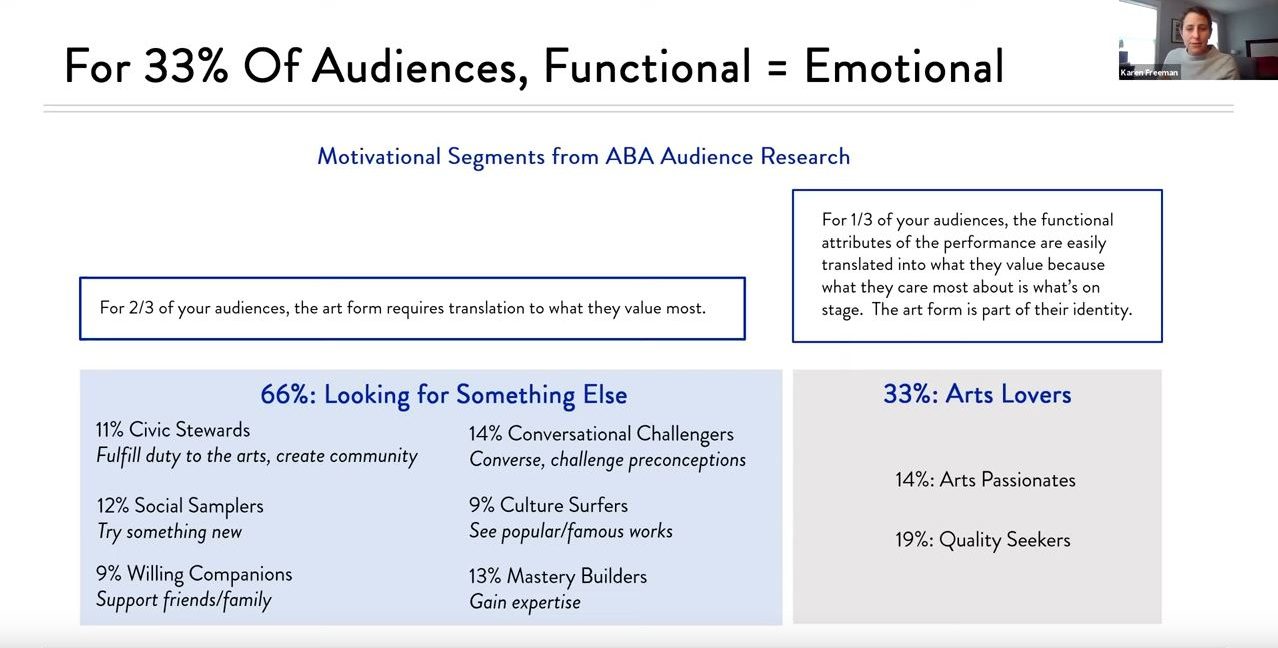Advisory Board for the Arts sponsored a webinar discussing how Utah Symphony shifted its marketing focus to emphasize emotional factors and shared values. Karen Freeman, Executive Director of Research at Advisory Board for the Arts, observed that this approach can be effective because “people make choices based on emotional factors but justify it with rational considerations.” Essentially, how this might manifest is you may choose what car to purchase based on an emotional association but decide it is a good choice based on things like gas mileage, dealer incentives and utility to your family.
Freeman says that providing a high quality art experience will attract people, yes, but that isn’t enough to sustain you. As noted in the chart below, for 1/3 of your audience, investment in the art form is a motivator because it is part of their identity. The other 2/3 have a different factors which motivate them.
The different motivating factors for the other 2/3 of audiences were identified by John Falk, using different category names, in Identity and the Museum Visitor Experience. I wrote about these categories in a bit more in detail on my personal blog for those interested in learning more.
Something to be particularly aware of however, is that regardless of whether someone feels emotionally connected to culture as part of their identity or not, the motivation for a specific visit may vary from visit to visit. One week they may visit based on a desire to gain expertise, next month it may be to support family and friends and next year it might so they can say they saw a famous work. Since what will resonate this time will be different from the last time, a variety of messaging needs to be employed for every opportunity being offered
Around the 13:15 point in the video, there are examples of Utah Symphony promotional materials which span the continuum of appeals, from functional benefit to emotional value. While it doesn’t appear the symphony created campaigns that evoked shared value, Freeman uses Dove’s “Real Beauty” campaign to illustrate what that might look like.
Utah Symphony employed the Zaltman Metaphor Elicitation Technique (ZMET) to get a sense of what people valued about the organization. At around the 17:45 they discuss how they asked people to bring in 10 images that represent the symphony that do not include any pictures of symphony, musicians or instruments. If you think this is a great idea you want to do, be prepared to communicate expectations very clearly, perhaps with some repetition. In the Q&A segment later in the video, Jonathan Miles, VP of Marketing & Public Relations at Utah Symphony says getting people to understand what they supposed to bring to the interview was just about the most difficult part of the process.
Using ZMET elicited some good results. Someone brought picture of an Adirondack chair explaining they felt the same sense of calm in the symphony as they did in their chair at the lake. Among the additional questions the interviewer might use were asking about any feelings that they couldn’t find appropriate picture for. What else might be in the picture if the frame is extended? Interviewees were also asked to provide sensory metaphors – what color, smell, touch associated was associated with or perhaps or not associated with attending the orchestra?
They also mentioned a simpler approach might be to use the 5 Whys. It is a technique popularized by Toyota where you ask “Why” type questions at least 5 times to get to the core of what motivates them. At the the 22 min point Freeman presents chart which sort of illustrates where the Why technique might lead.
The first why might elicit a response that someone values the symphony for live performance. Asking why live performance is important might get an answer of extraordinary experience. Why does that matter? Makes me a better person. Why is it important to be a better person? Creates a sense of inner harmony.
Freeman says if you only asked Why once or twice, you will end up focused on product features and benefits and not really learn about what people see is a value of the experience to them as a person.
Using ZMET did see an increase in sales, revenue and reactivated buyers and according to Jonathan Miles it also shifted the way symphony staff spoke internally about patrons and reframed decision making about the patron experience. The internal change probably had more far reaching influence in success than if they had employed this technique superficially as a formula for success.
Miles said instead of trying to find out those who were engaged with arts and culture at other places weren’t coming, they tried to learn more about the core values embraced by superfans and then help people who shared the values of superfans see how those values were manifested at Utah Symphony performances through the superfans’ eyes.
Last 30 min is Miles talking about how they conducted the interviews, things to keep in mind, and how he cultivated internal allies around the approach and campaigns.
One amusing coincidence they stumbled upon was that they used images in some of their ads (see ~53:15) which mimicked scanable links to Spotify songs so people thought they could listen to the same songs those depicted in the images were. They ends up scrambling to reissue the ads so that people could scan them to do just that.

